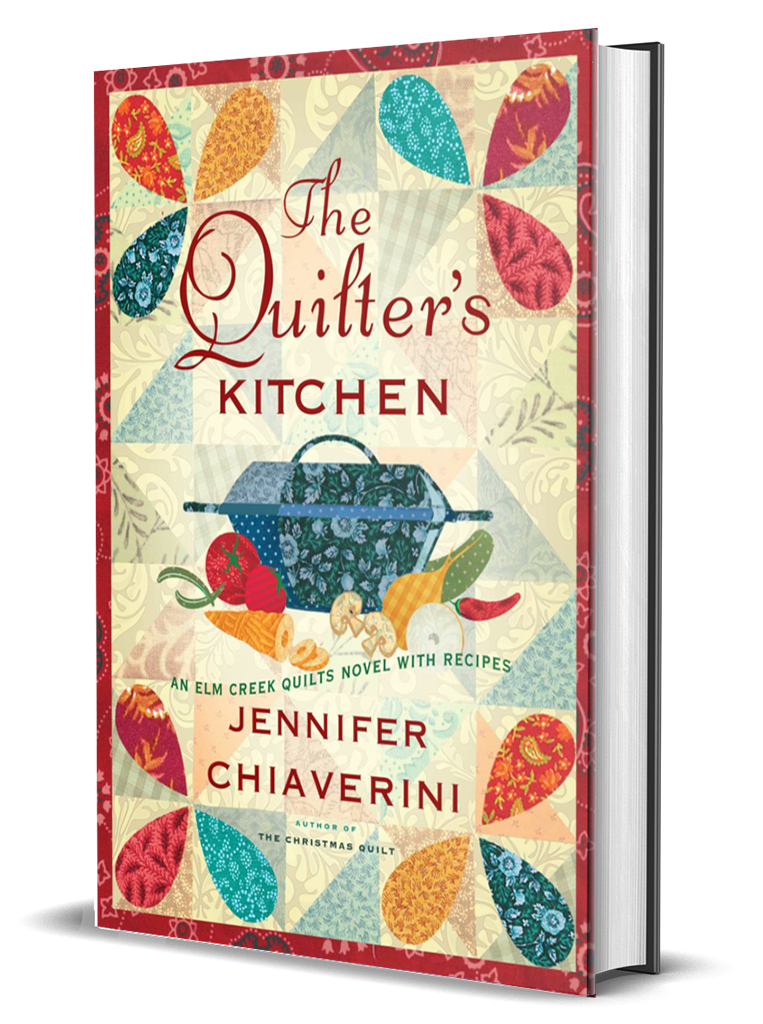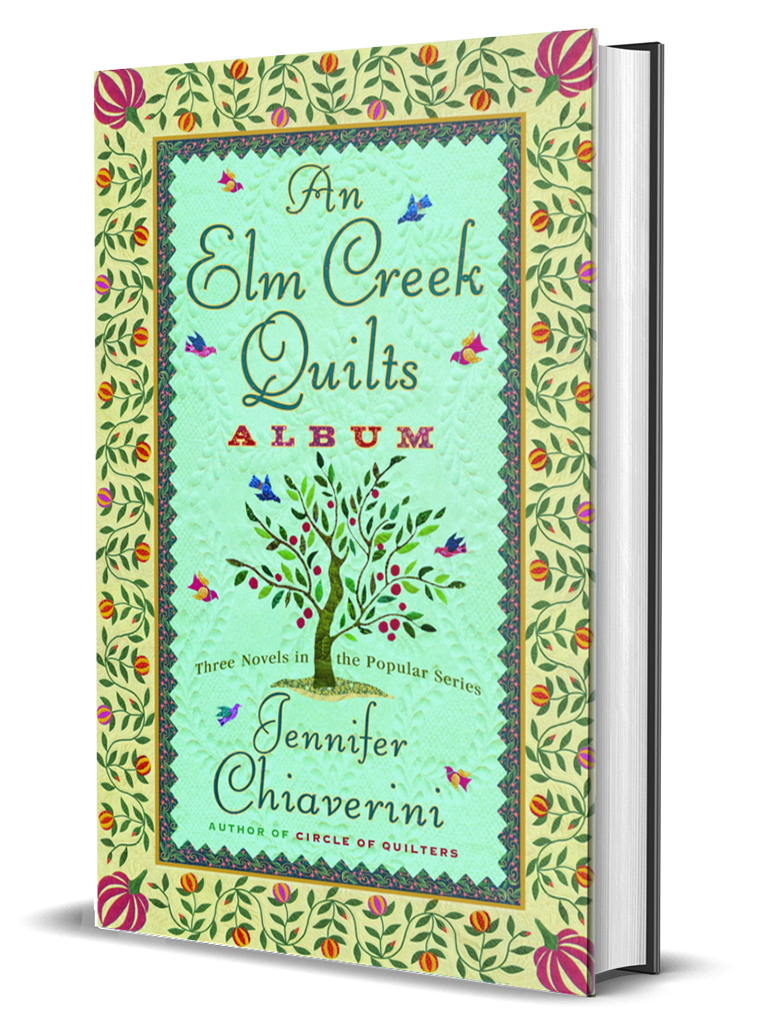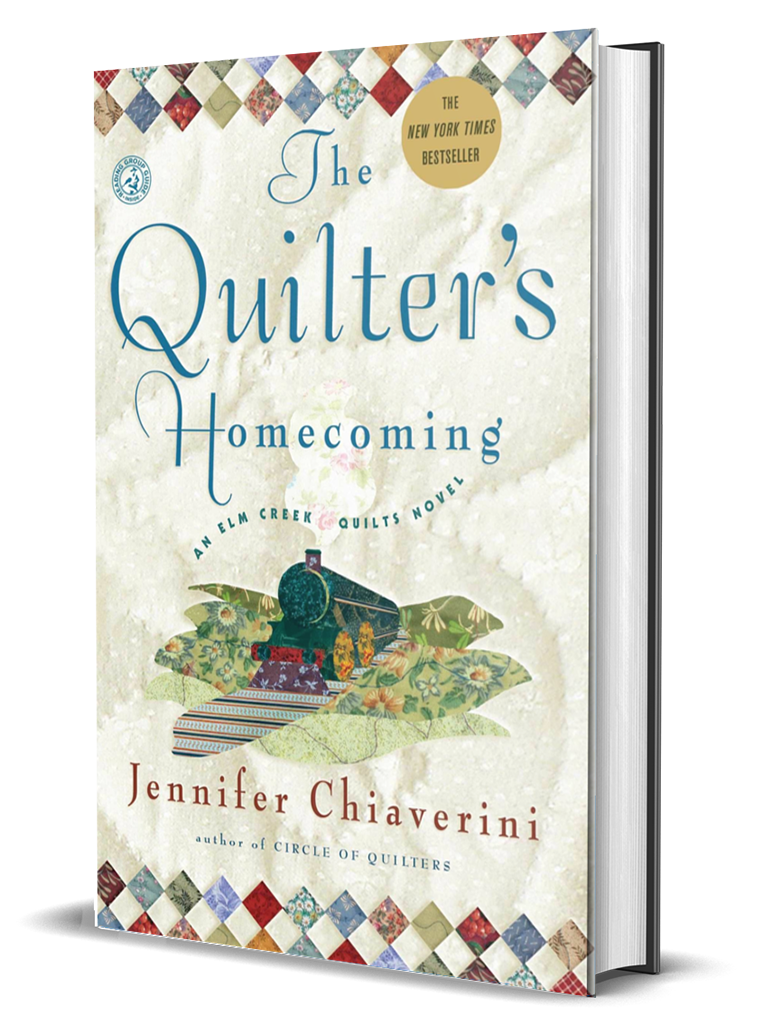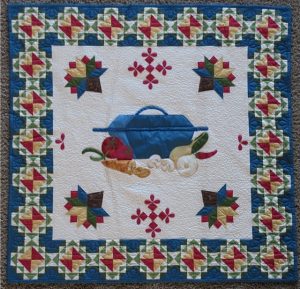
The Quilter’s Kitchen
Jennifer Chiaverini, author of the beloved Elm Creek Quilts series, follows her holiday-themed New York Times bestsellers, The Christmas Quilt and The New Year’s Quilt, with a flavorful offering for the season. For the Elm Creek Quilters, friends and business partners who run a quilting retreat in Pennsylvania, sharing recipes and dishes is a natural extension of the fellowship of their craft.
Yet even the fondest of traditions can benefit from innovation, so Master Quilter Sylvia Bergstrom Compson endeavors to “clear out the old and make way for the new” in Elm Creek Manor’s kitchen, which hasn’t been renovated for decades. At her side is Chef Anna, one of the newest members of the circle of quilters, who has accepted the position on the condition of the kitchen upgrade. She’s hoping to elevate her own status, too, from colleague to trusted friend.
“We need to find a way to make this kitchen serve up the spirit of Elm Creek Quilts just as it serves delicious meals,” Anna muses to Sylvia as they begin the project. “I want to honor all the traditions of the Bergstrom family as well as all the people, Elm Creek Quilters and campers alike, who make Elm Creek Quilt Camp such a unique place.”
The historic manor, dating to the mid-nineteenth century, houses a trove of all that its inhabitants have held most dear. As Sylvia and Anna explore the long-neglected corners of the kitchen’s cabinets, the details of events longs since transpired spring to life. An old gingham table cloth, Great-Aunt Lydia’s handmade aprons, a cornucopia made by Sylvia’s sister when she was a child, their mother’s favorite serving dish – each unearthed treasure prompts memories of times past, when celebrations throughout the year were steeped in good food and good company. These include not only Christmas, New Year’s, and Thanksgiving, but days special to those who have lived at Elm Creek over the years – the annual harvest dances that brought the community together before the Second World War, the family picnics, the happily shared potlucks. Anna learns, too, of a holiday that has more recently captured the Elm Creek Quilters’ collective heart – National Quilting Day, celebrated on the third Saturday in March since 1991.
As each celebration is considered, Anna contemplates the recipes she would serve: some traditional Elm Creek fare, such as the German Christmas cookie recipes handed down by the Bergstrom family or Bratwurst with Apples and Onions; others her own unique creations, Quilt Block cookies, Bee Tea, Tomato Mushroom Ragout (for Gnocchi), Gorgonzola Basil Dip. The actual recipes, which will make up the official “Elm Creek Cookbook” that Anna hopes to prepare in order to seal her place among the Elm Creek Quilters, are included—one hundred in all–created by renowned cookbook writer Sally Sampson especially for THE QUILTER’S KITCHEN.
Fans will be delighted to sample the famous Bergstrom Apple Strudel, which played a central role in Chiaverini’s first holiday tale, The Christmas Quilt. Here too are intimations of a special quilt, fashioned from the linens and aprons found in the old kitchen, which will celebrate the storied history of Elm Creek as only such a handicraft can.
A much-anticipated addition to the Elm Creek Quilts collection, THE QUILTER’S KITCHEN is a captivating tale of family, friendship, and holiday traditions.
Read an Excerpt from The Quilter’s Kitchen
Chapter One: Welcome Banquet
As Jeremy turned the car off the main highway from Waterford and onto the narrow, gravel road that wound through the leafy wood encircling the Bergstrom estate, Anna instinctively clutched her seat cushion with one hand and braced herself against the dashboard with the other. “Maybe when we’re done remodeling the kitchen,” she said, voicing shaking with each bump and jolt, “we can convince Sylvia to do something about this road.”
Jeremy kept his eyes on the winding way that led into the forest; if a car approached from the opposite direction, he would have to react quickly and pull halfway off the road to avoid a collision. Both sides of his car were already marked with fine scratches from past diversions into the underbrush. “I doubt it,” he replied, his wire-rimmed glasses sliding down his nose a millimeter or two with every pothole. “Sylvia’s a traditionalist. The longer you know her, the more you’ll realize that she’s reluctant to alter the old family estate too much.”
“She’s letting me make big changes to the kitchen,” Anna reminded him.
Jeremy shrugged and offered her his familiar cheerful, crooked grin. “Only because she didn’t think you’d take the job otherwise.”
As much as Anna was thrilled with her new position as the Elm Creek Manor’s chef, she had to admit that Sylvia had guessed correctly. She would never forget her first glimpse of the kitchen when she had come to the manor for her job interview. It was larger than she expected to find in a building constructed in 1858, but there was not a single appliance post-1945 except for a tiny microwave on the counter, possibly the first ever invented by the look of it. The pantry was spacious and well stocked, but poorly lit and so badly organized that it would have taken Anna longer to find ingredients for one of her signature dishes than to mix them together. And as for the cooking utensils left to soak in the sink… The whisk looked to be at least fifty years old, which wouldn’t have bothered her had it not been bent out of shape, and the hand mixer had rust, actual rust, on the handle. How the Elm Creek Quilters had managed to feed fifty-plus people three meals a day with that four-burner gas stove was a mystery, but Anna knew that she couldn’t work in such conditions, not after being spoiled by the sparkling clean, modern facilities at Waterford College. Fortunately Sylvia had agreed that the kitchen was long overdue for an upgrade, and she had accepted Anna’s condition for taking the job.
Now that Elm Creek Quilt Camp had ended for the season, Sylvia and Anna would launch the remodeling process in earnest. With weeks of planning and hours of consultation behind them, in two days they would usher in a team of contractors to tear out old cupboards and haul away old appliances, to knock out the wall between the kitchen and the west sitting room, to install new wiring, lighting, shelving, appliances, and everything else Anna desired and Sylvia’s budget would allow. If all went well, Anna would have a fully operational, professional kitchen in time for the holiday feasts she intended to prepare for her new colleagues.
She hoped, in time, that they would become her friends.
Late morning sunlight broke through the leafy wood, gold and rust and scarlet with autumn, as the road forked, wound through the trees, and emerged beside a sunlit apple orchard. They passed a red barn, climbed a low hill, and crossed the bridge over Elm Creek. All at once the manor came into view—three stories of gray stone and dark wood surrounded by autumnal beauty.
Anna knew the Elm Creek Quilters considered the grand manor a second home. She was an Elm Creek Quilter now, too, she reminded herself. Perhaps in time Elm Creek Manor would become as important to her as it was to her new co-workers.
On the other side of the creek, the road broadened into a parking lot circling two towering elms. “Call me when you want me to pick you up,” Jeremy offered as he parked near the foot of the back stairs.
“I can take the bus,” Anna said. She couldn’t help feeling as if she were imposing on his generosity. It was one thing for him to drive her to work when his girlfriend, Summer, had lived at the manor, but now that Summer was attending graduate school in Chicago, Jeremy had no reason to come so far out of his way. Anna and Jeremy were friends and neighbors, with apartments on opposite sides of the hall in a building not far from the Waterford College campus, but these almost daily drives were a lot to ask even of a friend. But every time Anna mentioned the bus, Jeremy shook his head and drove her anyway. Anna suspected that Summer had asked him to bring her since she was new, to help her feel less like an outsider. Or maybe the Elm Creek Quilters were afraid that she would grow tired of the long walk from the bus stop and resign, and they had enlisted Jeremy’s help to make sure she didn’t have to. Or maybe Jeremy was just a nice guy and she was taking advantage of him.
Whatever the reason, and despite the occasional pang of guilt, secretly Anna was glad that their carpooling had not ended with Summer’s departure. The bus’s circuitous route would have added two hours to her daily commute, and she would have missed Jeremy’s company.
“I’ll have my cell on,” Jeremy said, as if she had not mentioned the bus this time, either. Surely Summer had asked him to baby-sit her. That had to be it.
Anna returned Jeremy’s grin, waved goodbye, and climbed the four stone steps to the back door of Elm Creek Manor. The kitchen was through the first doorway on the left, and from within came the sound of someone clattering pots and pans and what sounded like cookie sheets.
Anna hung her jacket in the hall closet and entered the kitchen, which already seemed strangely bare with the long wooden table and the benches that usually flanked it missing. Clad in a burgundy cardigan, her silver-grey hair held back in a tortoise shell comb, Sylvia Bergstrom Compson, Master Quilter and founder of Elm Creek Quilts, sat cross-legged on the floor nearby, transferring skillets and saucepans into a carton. She glanced up and smiled, feathery lines etched around her eyes and mouth deepening, but the fondness in her expression did not lessen her air of command, as if she were a woman who was accustomed to voicing her opinions and having others carefully listen.
“Matt and Andrew moved the table and benches into the dining room, out of the way,” Sylvia said, answering Anna’s unspoken question. Brushing dust from her hands, she rose, far more slender than Anna and nearly as tall, with only the slightest stoop to her shoulders. A pair of glasses hung around her neck on a silver chain. “I haven’t decided what to do with them yet. They’ll seem out of place in our new kitchen, and yet they’ve been in the family so long I can’t bear to get rid of them.”
“I’m sure we can find a place for them somewhere,” said Anna. “We don’t have to get rid of everything, not if it’s useful or has sentimental value.”
“You’re thinking just like my Bergstrom ancestors,” said Sylvia dryly. “Remind me to show you the attic someday. No, we can’t keep everything. That’s the whole point of our work today, isn’t it, to clear out the old and make way for the new?”
Anna hesitated. “I thought we were just going to pack up the dishes and cookware and move everything out of the way before the contractors demolish the cabinets. I assumed we’d put everything back afterwards.”
“And despoil your lovely new kitchen with rusty old pots and pans?” Sylvia shook her head. “Out of the question.”
“Sometimes old pots cook better than new,” said Anna, thinking of the cast-iron cookware she had long admired. She was itching to cook up a ratatouille in the Dutch oven that had belonged to Sylvia’s great-aunt. “Let’s not discard things arbitrarily just because they clash with the paint and granite.”
Sylvia smiled, amused by Anna’s reference to their many contentious debates with their contractor’s designer, who held strong opinions about the merits of particular color combinations. “Agreed. If I want to toss something out but you want to keep it, I’ll let you have the last word. This kitchen will be your workspace, after all.”
“But it’s more than that,” Anna said. “A kitchen is the heart of a home. Think of how much time the Elm Creek Quilters spend in this room, discussing quilt patterns and lesson plans over coffee and cake. Your guests, too. In the few weeks I’ve been here, I’ve noticed that time and time again, quilt campers find their way to the kitchen.”
“They follow their noses,” Sylvia said. “More so than ever since you came on board.”
“It’s also the first room campers pass when they come through the back door,” Anna added, “and except for registration morning, that’s the door they use most frequently.”
Sylvia nodded, thoughtful. “It never occurred to me, but perhaps the kitchen is just as important as the front foyer is for offering our guests a warm welcome to the manor.”
In Anna’s opinion, the kitchen played that role in every home. “We could always move the registration tables in here,” she joked as she knelt beside a lower cabinet. Inside she found cake pans of all shapes and sizes, definitely worth keeping. She pulled over an empty carton and carefully stacked the pans within it.
“Even after we knock out the wall and expand into the sitting room, we won’t have enough space for that,” said Sylvia. “Our campers will have to wait until the Welcome Banquet to get an official greeting from your kitchen.”
The Welcome Banquet: the eagerly anticipated commencement of each new week of camp. The banquet hall, transformed by white linen tablecloths, crystal, and candlelight, set the proper festive tone for the days ahead, a week devoted to learning, sharing, and enjoying a respite from the cares of ordinary life. Anna had prepared the delicious feast for the last few weeks of the camp season, and she had been delighted by the campers’ rave reviews—not to mention those of the Elm Creek Quilters. She was pleased to know that she played such an important role in creating a celebratory mood and a sense of anticipation for the week ahead.
But many quilt campers found their way to the kitchen before they sat down to supper in the banquet hall.
“The kitchen has to be a welcoming place for our campers,” Anna mused, sitting back on her heels and forgetting the bakeware for a moment.
“It will be,” Sylvia promised. “The new seating will give campers a place to relax with a cup of coffee or a snack, or if they just want a cozy place to chat with friends. You might find yourself entertaining an audience while you prepare meals. I hope you won’t mind.”
“Not at all. It would be fun, like having my own cooking show.” Anna drew her long, dark brown French braid over her shoulder, tucked a few loose strands back into the plait, and tightened the band on the end. “But that makes it even more important to create an inviting atmosphere, don’t you think? Cozy seats, coffee, and snacks aren’t enough. We need to find a way to make this kitchen serve up the spirit of Elm Creek Quilts just as it serves delicious meals. Somehow—and I don’t know how yet—we have to give our guests a sense of the history of the manor as well as its exciting present. I want to honor the traditions of the Bergstrom family as well as all the people, Elm Creek Quilters and campers alike, who make Elm Creek Quilt Camp such a unique place. I want to bring all those flavors together, right here in this room.”
Sylvia regarded Anna over the rims of her glasses for a moment. When a smile quirked in the corners of her mouth, Anna knew her new employer was pleased with her ideas, but also amused that she hoped for so much from a simple kitchen. “That’s a tall order,” said Sylvia, brushing crumbs from a dented muffin tin.
“I’ve trained in some of the finest kitchens in Pennsylvania, under some of the most demanding chefs you’d ever meet,” Anna replied. “I know how to fill a tall order.”
Sylvia smiled. “Spoken like a true Elm Creek Quilter.”
Anna fervently hoped so. She didn’t feel like one, not quite yet, and she wanted to, more than anything.









